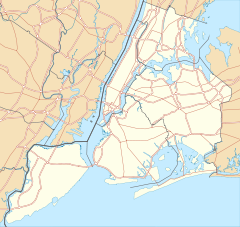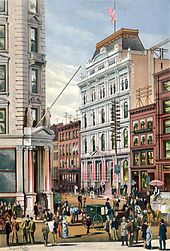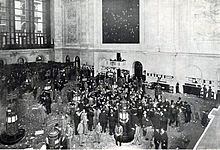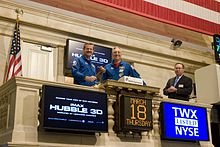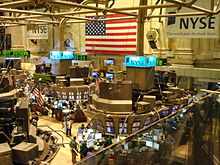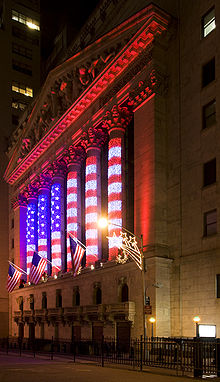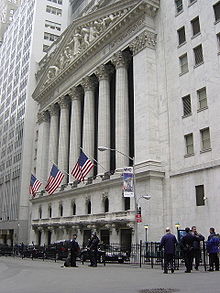- New York Stock Exchange
-
New York Stock Exchange 
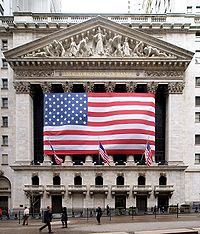
Type Stock exchange Location New York City, United States Founded March 8, 1817 Owner NYSE Euronext Key people Duncan L. Niederauer (CEO) Currency United States dollar No. of listings 2,317 MarketCap US$13.39 trillion (Dec 2010)[1] Volume US$1.439 trillion (Nov 2010) Indexes NYSE Composite
Dow Jones Industrial Average
S&P 500Website nyse.com New York Stock Exchange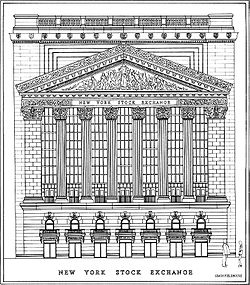 Front Elevation of New York Stock Exchange
Front Elevation of New York Stock ExchangeCoordinates: 40°42′24.6″N 74°0′39.7″W / 40.706833°N 74.011028°WCoordinates: 40°42′24.6″N 74°0′39.7″W / 40.706833°N 74.011028°W Built: 1903 Architect: Trowbridge & Livingston; George B. Post Architectural style: Classical Revival Governing body: Private NRHP Reference#: 78001877 Significant dates Added to NRHP: June 2, 1978[2] Designated NHL: June 2, 1978[3] The New York Stock Exchange (NYSE) is a stock exchange located at 11 Wall Street in Lower Manhattan, New York City, USA. It is by far the world's largest stock exchange by market capitalization of its listed companies at US$13.39 trillion as of Dec 2010.[4] Average daily trading value was approximately US$153 billion in 2008.
The NYSE is operated by NYSE Euronext, which was formed by the NYSE's 2007 merger with the fully electronic stock exchange Euronext. The NYSE trading floor is located at 11 Wall Street and is composed of four rooms used for the facilitation of trading. A fifth trading room, located at 30 Broad Street, was closed in February 2007. The main building, located at 18 Broad Street, between the corners of Wall Street and Exchange Place, was designated a National Historic Landmark in 1978,[5] as was the 11 Wall Street building.[3][6][7]
Contents
History
The origin of the NYSE can be traced to May 17, 1792, when the Buttonwood Agreement was signed by 24 stock brokers outside of 68 Wall Street in New York under a buttonwood tree on Wall Street.[8] On March 8, 1817, the organization drafted a constitution and renamed itself the "New York Stock & Exchange Board." Anthony Stockholm was elected the Exchange's first president.
The first central location of the Exchange was a room, rented in 1792 for $200 a month, located at 40 Wall Street. After that location was destroyed in the Great Fire of New York in 1835, the Exchange moved to a temporary headquarters. In 1863, the New York Stock & Exchange Board changed to its current name, the New York Stock Exchange. In 1865, the Exchange moved to 10–12 Broad Street.
The New York Stock Exchange was closed for ten days starting September 20, 1873, because of the Panic of 1873.[9]
The volume of stocks traded increased sixfold in the years between 1896 and 1901, and a larger space was required to conduct business in the expanding marketplace.[10] Eight New York City architects were invited to participate in a design competition for a new building; ultimately, the Exchange selected the neoclassic design submitted by architect George B. Post. Demolition of the Exchange building at 10 Broad Street, and adjacent buildings, started on May 10, 1901.
The new building, located at 18 Broad Street, cost $4 million and opened on April 22, 1903. The trading floor, at 109 × 140 feet (33 × 42.5 m), was one of the largest volumes of space in the city at the time, and had a skylight set into a 72-foot (22 m)-high ceiling. The main façade of the building features six tall columns with Corinthian capitals, topped by a marble pediment containing high-relief sculptures by John Quincy Adams Ward with the collaboration of Paul Wayland Bartlett, carved by the Piccirilli Brothers, representing Integrity Protecting the Works of Man. The building was listed as a National Historic Landmark and added to the National Register of Historic Places on June 2, 1978.[11]
In 1922, a building for offices, designed by Trowbridge & Livingston, was added at 11 Wall Street, as well as a new trading floor called the Garage. Additional trading floor space was added in 1969 the Blue Room, and in 1988 the EBR or Extended Blue Room, with the latest technology for information display and communication. Yet another trading floor was opened at 30 Broad Street called the Bond Room in 2000. As the NYSE introduced its hybrid market, a greater proportion of trading came to be executed electronically, and due to the resulting reduction in demand for trading floor space, the NYSE decided to close the 30 Broad Street trading room in early 2006. As the adoption of electronic trading continued to reduce the number of traders and employees on the floor, in late 2007, the NYSE closed the rooms created by the 1969 and 1988 expansions.
The Stock Exchange Luncheon Club was situated on the seventh floor from 1898 until its closure in 2006.[12]
The NYSE announced its plans to merge with Archipelago on April 21, 2005, in a deal intended to reorganize the NYSE as a publicly traded company. NYSE's governing board voted to merge with rival Archipelago on December 6, 2005, and become a for-profit, public company. It began trading under the name NYSE Group on March 8, 2006. A little over one year later, on April 4, 2007, the NYSE Group completed its merger with Euronext, the European combined stock market, thus forming the NYSE Euronext, the first transatlantic stock exchange.
Presently, Marsh Carter is Chairman of the New York Stock Exchange, having succeeded John S. Reed and the CEO is Duncan Niederauer, having succeeded John Thain.
Notable events
The exchange was closed shortly after the beginning of World War I (July 31, 1914), but it partially re-opened on November 28 of that year in order to help the war effort by trading bonds, and completely reopened for stock trading in mid-December.
On September 16, 1920, a bomb exploded on Wall Street outside the NYSE building, killing 33 people and injuring more than 400. The perpetrators were never found. The NYSE building and some buildings nearby, such as the JP Morgan building, still have marks on their façades caused by the bombing.
The Black Thursday crash of the Exchange on October 24, 1929, and the sell-off panic which started on Black Tuesday, October 29, are often blamed for precipitating the Great Depression of 1929. In an effort to try to restore investor confidence, the Exchange unveiled a fifteen-point program aimed to upgrade protection for the investing public on October 31, 1938.
On October 1, 1934, the exchange was registered as a national securities exchange with the U.S. Securities and Exchange Commission, with a president and a thirty-three member board. On February 18, 1971 the non-profit corporation was formed, and the number of board members was reduced to twenty-five.
One of Abbie Hoffman's well-known publicity stunts took place in 1967, when he led members of the Yippie movement to the Exchange's gallery. The provocateurs hurled fistfuls of real dollars mixed with fake dollars toward the trading floor below. Some traders booed, and some collected the apparent bounty.[citation needed] The press was quick to respond and, by evening, the event had been reported around the world.[citation needed] (The stock exchange later spent $20,000 to enclose the gallery with bulletproof glass.)[citation needed] Hoffman wrote a decade later, "We didn’t call the press; at that time we really had no notion of anything called a media event."[13]
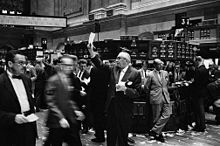 NYSE's stock exchange traders floor before the introduction of electronic readouts and computer screens.
NYSE's stock exchange traders floor before the introduction of electronic readouts and computer screens.
On October 19, 1987, the Dow Jones Industrial Average (DJIA) dropped 508 points, a 22.6% loss in a single day, the second-biggest one-day drop the exchange had experienced, prompting officials at the exchange to invoke for the first time the "circuit breaker" rule to halt all trading. This was a very controversial move and led to a quick change in the rule; trading now halts for an hour, two hours, or the rest of the day when the DJIA drops 10, 20, or 30 percent, respectively. The rationale behind the trading halt was to give investors a chance to cool off and reevaluate their positions. Black Monday was followed by Terrible Tuesday, a day in which the Exchange's systems did not perform well and some people had difficulty completing their trades.
Consequently,[vague] there was another major drop for the Dow on October 13, 1989; the Mini-Crash of 1989. The crash was apparently caused by a reaction to a news story of a $6.75 billion leveraged buyout deal for UAL Corporation, the parent company of United Airlines, which broke down. When the UAL deal fell through, it helped trigger the collapse of the junk bond market causing the Dow to fall 190.58 points, or 6.91 percent.
Similarly, there was a panic in the financial world during the year of 1997; the Asian Financial Crisis. Like the fall of many foreign markets, the Dow suffered a 7.18% drop in value (554.26 points) on October 27, 1997, in what later became known as the 1997 Mini-Crash but from which the DJIA recovered quickly.
On January 26, 2000, an altercation during filming of the music video for "Sleep Now in the Fire", which was directed by Michael Moore, caused the doors of the exchange to be closed and the band, Rage Against the Machine, to be escorted from the site by security,[14] after band members attempted to gain entry into the exchange.[15] Trading on the exchange floor, however, continued uninterrupted.[16]
On May 6, 2010, the Dow Jones Industrial Average posted its largest intraday percentage drop since the October 19, 1987 crash, with a 998 point loss later being called the Flash Crash (As the drop occurred in minutes before rebounding). The SEC and CFTC published a report on the event, although it did not come to a conclusion as to the cause. The regulators found no evidence that the fall was caused by erroneous ("fat finger") orders.[17]
Trading
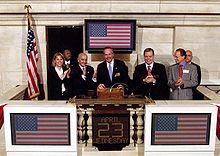 U.S. Secretary of Commerce Donald L. Evans rings the opening bell at the NYSE on April 23, 2003. Former chairman Jack Womack is also in this picture.
U.S. Secretary of Commerce Donald L. Evans rings the opening bell at the NYSE on April 23, 2003. Former chairman Jack Womack is also in this picture.
The New York Stock Exchange (sometimes referred to as "the Big Board") provides a means for buyers and sellers to trade shares of stock in companies registered for public trading. The NYSE is open for trading Monday through Friday between 9:30 am – 4:00 pm ET, with the exception of holidays declared by the Exchange in advance.
On the trading floor, the NYSE trades in a continuous auction format, where traders can execute stock transactions on behalf of investors. They will gather around the appropriate post where a specialist broker, who is employed by an NYSE member firm (that is, he/she is not an employee of the New York Stock Exchange), acts as an auctioneer in an open outcry auction market environment to bring buyers and sellers together and to manage the actual auction. They do on occasion (approximately 10% of the time) facilitate the trades by committing their own capital and as a matter of course disseminate information to the crowd that helps to bring buyers and sellers together. The auction process moved toward automation in 1995 through the use of wireless hand held computers (HHC). The system enabled traders to receive and execute orders electronically via wireless transmission. On September 25, 1995, NYSE member Michael Einersen, who designed and developed this system, executed 1000 shares of IBM through this HHC ending a 203 year process of paper transactions and ushering in an era of automated trading.
As of January 24, 2007, all NYSE stocks can be traded via its electronic Hybrid Market (except for a small group of very high-priced stocks). Customers can now send orders for immediate electronic execution, or route orders to the floor for trade in the auction market. In the first three months of 2007, in excess of 82% of all order volume was delivered to the floor electronically.[18]
Until 2005, the right to directly trade shares on the exchange was conferred upon owners of the 1366 "seats". The term comes from the fact that up until the 1870s NYSE members sat in chairs to trade. In 1868, the number of seats was fixed at 533, and this number was increased several times over the years. In 1953, the number of seats was set at 1366. These seats were a sought-after commodity as they conferred the ability to directly trade stock on the NYSE. Seat prices varied widely over the years, generally falling during recessions and rising during economic expansions. The most expensive inflation-adjusted seat was sold in 1929 for $625,000, which, today, would be over six million dollars. In recent times, seats have sold for as high as $4 million in the late 1990s and as low as $1 million in 2001. In 2005, seat prices shot up to $3.25 million as the exchange entered into an agreement to merge with Archipelago and become a for-profit, publicly traded company. Seat owners received $500,000 in cash per seat and 77,000 shares of the newly formed corporation. The NYSE now sells one-year licenses to trade directly on the exchange. Licences for floor trading are available for $40,000 and a licence for bond trading is available for as little as $1000 as of 2010.[19] Neither are resell-able, but may be transferable in during the change of ownership of a cooperation holding a trading licence.
NYSE Composite Index
In the mid-1960s, the NYSE Composite Index (NYSE: NYA) was created, with a base value of 50 points equal to the 1965 yearly close.[20] This was done to reflect the value of all stocks trading at the exchange instead of just the 30 stocks included in the Dow Jones Industrial Average. To raise the profile of the composite index, in 2003 the NYSE set its new base value of 5,000 points equal to the 2002 yearly close.
Timeline
In 1792, The NYSE acquires its first traded securities.[21][22] In 1817, The constitution of the New York Stock and Exchange Board is adopted.[23] In 1867, The First Stock Ticker.[24] In 1896, Dow Jones Industrial Average first published in The Wall Street Journal.[24] In 1903, NYSE moves into new quarters at 18 Broad Street. In 1906, Dow exceeds 100 on January 12. In 1907, Panic of 1907. In 1914, World War I causes the longest exchange shutdown: four months, two weeks; re-opening December 12 brings the largest one-day percentage drop in the DJIA (24.4%). In 1915, Market price is given in dollars. In 1929, Central quote system established; Black Thursday, October 24 and Black Tuesday, October 29 signal the end of the Roaring Twenties bull market. In 1943, Trading floor is opened to women.[25] In 1949, Longest (eight-year) bull market begins.[26]
In 1954, Dow surpasses its 1929 peak in inflation-adjusted dollars. In 1956, Dow closes above 500 for the first time on March 12. In 1966, the NYSE begins a composite index of all listed common stocks. This is referred to as the "Common Stock Index" and is transmitted daily. The starting point of the index is 50. It is later renamed the NYSE Composite Index.[27] In 1967, Protesters led by Abbie Hoffman throw mostly fake dollar bills at traders from gallery, leading to the installation of bullet-proof glass. In 1970, Securities Investor Protection Corporation established. In 1971, NYSE recognized as Not-for-Profit organization.[27] In 1972, Dow closes above 1,000 for the first time on November 14. In 1977, Foreign brokers are admitted to NYSE. In 1980, New York Futures Exchange established. In 1982, Longest bull market in DJIA history begins. In 1987, Black Monday, October 19, sees the second-largest one-day DJIA percentage drop (22.6%) in history. In 1991, Dow exceeds 3,000. In 1995, Dow exceeds 5,000. In 1996, Real-time ticker introduced.[28] In 1999, Dow exceeds 10,000 on March 29. In 2000, Dow peaks at 11,722.98 on January 14; first NYSE global index is launched under the ticker NYIID.
In 2001, Trading in fractions (n/16) ends, replaced by decimals (increments of $.01, see Decimalization); September 11, 2001 attacks occur, closing NYSE for 4 sessions. In 2003, NYSE Composite Index relaunched and value set equal to 5,000 points. In 2006, NYSE and ArcaEx merge, creating NYSE Arca and forming the publicly owned, for-profit NYSE Group, Inc.; in turn, NYSE Group merges with Euronext, creating the first trans-Atlantic stock exchange group; DJIA tops 12,000 on October 19. In 2007, US President George W. Bush shows up unannounced to the Floor about an hour and a half before a Federal Open Market Committee interest-rate decision on January 31.[29] NYSE announces its merger with the American Stock Exchange; NYSE Composite closes above 10,000 on June 1; DJIA exceeds 14,000 on July 19 and closes at an all time peak of 14,164.53 on October 9. This was the peak before the 2008–2009 bust.
On September 15, 2008, the DJIA loses more than 500 points amid fears of bank failures, resulting in a permanent prohibition of naked short selling and a three-week temporary ban on all short selling of financial stocks; in spite of this, record volatility continues for the next two months, culminating at 5½-year market lows. In 2009, Dow closes at 6547.05 on March 9 reaching a 12 year low. Returns to 10,015.86 on October 14.
Merger with Deutsche Börse
On February 15, 2011 NYSE and Deutsche Börse announced their merger to form a new company, as yet unnamed, wherein Deutsche Börse shareholders will have 60% ownership of the new entity, and NYSE-Euronext shareholders will have 40%.
See also
New York Stock Exchange listed stocks: 0-9 - A - B - C - D - E - F - G - H - I - J - K - L - M - N - O - P - Q - R - S - T - U - V - W - X - Y - Z
- Economy of New York City
- List of American stock exchanges
- List of presidents of the New York Stock Exchange
- U.S. Securities and Exchange Commission
- List of market opening times
Notes
- ^ World-exchanges.org
- ^ "National Register Information System". National Register of Historic Places. National Park Service. 2007-01-23. http://nrhp.focus.nps.gov/natreg/docs/All_Data.html.
- ^ a b "New York Stock Exchange". National Historic Landmark summary listing. National Park Service. September 17, 2007. http://tps.cr.nps.gov/nhl/detail.cfm?ResourceId=1776&ResourceType=Building.
- ^ World-exchanges.org
- ^ National Park Service, National Historic Landmarks Survey, New York, retrieved May 31, 2007.
- ^ George R. Adams (March 1977). "New York Stock Exchange National Register of Historic Places Inventory-Nomination (1MB PDF)" (PDF). National Park Service. http://pdfhost.focus.nps.gov/docs/NHLS/Text/78001877.pdf. Retrieved January 30, 2008.
- ^ "National Register of Historic Places Inventory-Nomination (1MB PDF)" (PDF). National Park Service. 1983. http://pdfhost.focus.nps.gov/docs/NHLS/Photos/78001877.pdf.
- ^ Terrell, Ellen (August 2010). "History of the New York Stock Exchange". The Library of Congress. http://www.loc.gov/rr/business/hottopic/stock_market.html. Retrieved 1 November 2011.
- ^ Historical economics: art or science?, page 321, Charles Poor Kindleberger, University of California Press, 1990. ISBN 9780520073432
- ^ The Building NYSE Group history
- ^ National Register Number: 78001877 National Historic Landmark
- ^ Edmonston, Peter (April 28, 2006). "Where Wall Street Meets to Eat, the Last Lunch". New York Times. http://www.nytimes.com/2006/04/28/business/28lunch.html?_r=1. Retrieved January 29, 2009.
- ^ Abbie Hoffman, Soon to be a Major Motion Picture, p. 100, Putnam, 1980.
- ^ "Rage against Wall Street". Green Left Weekly #397. March 15, 2000. http://www.greenleft.org.au/2000/397/24186. Retrieved October 11, 2007.
- ^ Basham, David (January 28, 2000). "Rage Against the Machine Shoots New Video With Michael Moore". MTV News. http://www.mtv.com/news/articles/1433553/20000128/rage_against_the_machine.jhtml. Retrieved February 17, 2007.
- ^ "New York Stock Exchange Special Closings, 1885-date" (PDF). NYSE Group. http://www.nyse.com/pdfs/closings.pdf. Retrieved April 7, 2007.
- ^ SEC.gov
- ^ Shell, Adam (July 12, 2007). "Technology squeezes out real, live traders". USA Today. http://www.usatoday.com/money/markets/2007-07-11-nyse-traders_N.htm.
- ^ "NYSE Licence Application Forms". NYSE Trading Licence Publication. http://www.nyse.com/pdfs/NYSE-Trading_License_Forms.pdf.
- ^ Waring, David. "The New York Stock Exchange(NYSE)." Informed Trades, 2007, p.1
- ^ "NYSE, New York Stock Exchange > About Us > History > Firsts & Records". Nyse.com. http://www.nyse.com/about/history/1022221392987.html. Retrieved June 10, 2010.
- ^ "NYSE, New York Stock Exchange – About Us – History – Timeline – Timeline 2008 Specialists are Transformed into Designated Market Makers (DMMs)". Nyse.com. January 1, 1991. http://www.nyse.com/about/history/timeline_trading.html. Retrieved June 10, 2010.
- ^ "NYSE, New York Stock Exchange – About Us – History – Timeline – Timeline". Nyse.com. http://www.nyse.com/about/history/timeline_chronology_index.html. Retrieved June 10, 2010.
- ^ a b "NYSE, New York Stock Exchange – About Us – History – Timeline – Timeline". Nyse.com. http://www.nyse.com/about/history/timeline_1860_1899_index.html. Retrieved June 10, 2010.
- ^ NYSE: Timeline"
- ^ "NYSE, New York Stock Exchange – About Us – History – Timeline – Timeline". Nyse.com. http://www.nyse.com/about/history/timeline_1940_1959_index.html. Retrieved June 10, 2010.
- ^ a b "NYSE, New York Stock Exchange – About Us – History – Timeline – Timeline". Nyse.com. December 20, 1967. http://www.nyse.com/about/history/timeline_1960_1979_index.html. Retrieved June 10, 2010.
- ^ "NYSE, New York Stock Exchange – About Us – History – Timeline 1995 Video: Trading Posts Upgrade". Nyse.com. January 1, 1991. http://www.nyse.com/about/history/timeline_1980_1999_index.html. Retrieved June 10, 2010.
- ^ Katy Byron (January 31, 2007). "President Bush makes surprise visit to NYSE". CNN Money (Cable News Network). http://money.cnn.com/2007/01/31/news/newsmakers/markets_bush/index.htm?postversion=2007013115. Retrieved February 20, 2007.
References
- Buck, James E. (1992). The New York Stock Exchange: The First 200 Years. Greenwich Pub. Group. ISBN 0944641024.
- Geisst, Charles R. (2004). Wall Street: A History – From its Beginnings to the Fall of Enron. Oxford University Press. ISBN 0195170601.
- Kent, Zachary (1990). The Story of the New York Stock Exchange. Scholastic Library Pub.. ISBN 0516047485.
- Sloane, Leonard (1980). The Anatomy of the Floor. Doubleday. ISBN 0385122497.
- Sobel, Robert (1975). N.Y.S.E.: A History of the New York Stock Exchange, 1935–1975. Weybright and Talley. ISBN 0679401245.
External links
- Official website
- Price of membership and a seat
- New York Stock Exchange collected news and commentary at The New York Times
U.S. National Register of Historic Places in New York Lists by county Albany • Allegany • Bronx • Broome • Cattaraugus • Cayuga • Chautauqua • Chemung • Chenango • Clinton • Columbia • Cortland • Delaware • Dutchess • Erie • Essex • Franklin • Fulton • Genesee • Greene • Hamilton • Herkimer • Jefferson • Kings (Brooklyn) • Lewis • Livingston • Madison • Monroe • Montgomery • Nassau • New York (Manhattan) • Niagara • Oneida • Onondaga • Ontario • Orange • Orleans • Oswego • Otsego • Putnam • Queens • Rensselaer • Richmond (Staten Island) • Rockland • Saratoga • Schenectady • Schoharie • Schuyler • Seneca • St. Lawrence • Steuben • Suffolk • Sullivan • Tioga • Tompkins • Ulster • Warren • Washington • Wayne • Westchester • Wyoming • Yates

Lists by city Albany • Buffalo • New Rochelle • New York City (Bronx · Brooklyn · Queens · Staten Island · Manhattan: Below 14th St. · 14th–59th St. · 59th–110th St. · Above 110th St. · Minor islands) • Peekskill • Poughkeepsie • Rhinebeck • Rochester • Syracuse • YonkersOther lists Keeper of the Register • History of the National Register of Historic Places • Property types • Historic district • Contributing property World Federation of Exchanges (WFE) Members Amman Stock Exchange · Athens Exchange · Australian Securities Exchange · Bermuda Stock Exchange · BM&F Bovespa · Bolsa de Comercio de Buenos Aires · Bolsa de Comercio de Santiago · Bolsa de Valores de Colombia · Bolsa de Valores de Lima · Bolsa Mexicana de Valores · Bolsas y Mercados Españoles · Bombay Stock Exchange · Borsa Italiana · Budapest Stock Exchange · Bursa Malaysia · Casablanca Stock Exchange · CBOE · CME Group · Colombo Stock Exchange · Cyprus Stock Exchange · Deutsche Börse · Egyptian Exchange · Hong Kong Exchanges and Clearing · Indonesia Stock Exchange · IntercontinentalExchange · International Securities Exchange · Irish Stock Exchange · Istanbul Stock Exchange · Johannesburg Stock Exchange · Korea Stock Exchange · Ljubljana Stock Exchange · London Stock Exchange · Luxembourg Stock Exchange · Malta Stock Exchange · Moscow Interbank Currency Exchange · NASDAQ OMX · NASDAQ OMX Armenia · NASDAQ OMX Copenhagen · NASDAQ OMX Helsinki · NASDAQ OMX Iceland · NASDAQ OMX Riga · Nasdaq OMX Stockholm · NASDAQ OMX Tallinn · NASDAQ OMX Vilnius · National Stock Exchange of India · NYSE Euronext Amsterdam · NYSE Euronext Brussels · NYSE Euronext Lisbon · NYSE Euronext New York · NYSE Euronext Paris · Osaka Securities Exchange · Oslo Børs · Philippine Stock Exchange · Saudi Stock Exchange · Shanghai Stock Exchange · Shenzhen Stock Exchange · Singapore Exchange · SIX Swiss Exchange · Stock Exchange of Mauritius · Stock Exchange of Thailand · Taiwan Stock Exchange · Tehran Stock Exchange · Tel Aviv Stock Exchange · TMX Group · Tokyo Stock Exchange · Warsaw Stock Exchange · Wiener Börse
Associates Depository Trust & Clearing Corporation · Financial Industry Regulatory Authority (FINRA) · LCH.Clearnet · Options Clearing Corporation · Takasbank
Affiliates Abu Dhabi Securities Exchange · Beirut Stock Exchange · Bucharest Stock Exchange · GreTai Securities Market · HoChiMinh Stock Exchange · Karachi Stock Exchange · Kazakhstan Stock Exchange · Muscat Securities Market · Nairobi Stock Exchange · Namibian Stock Exchange · National Stock Exchange · Nigerian Stock Exchange · RTS Exchange · Taiwan Futures Exchange · Zhengzhou Commodity Exchange
Correspondents Bahrain Bourse · Baku Interbank Currency Exchange · Banja Luka Stock Exchange · Barbados Stock Exchange · Belgrade Stock Exchange · Bolsa de Comercio de Rosario · Bolsa de Valores de Panamá · Bolsa Nacional de Valores · Borse Dubai · Bourse des Valeurs Mobilières de Tunis · Bourse Régionale des Valeurs Mobiliéres · Bratislava Stock Exchange · Bulgarian Stock Exchange – Sofia · Cayman Islands Stock Exchange · Chittagong Stock Exchange · CNSX Markets · Ghana Stock Exchange · Kuwait Stock Exchange · Libyan Stock Market · Lusaka Stock Exchange · Montenegro Stock Exchange · Multi Commodity Exchange of India · Palestine Exchange · PFTS Stock Exchange · Port Moresby Stock Exchange · Qatar Exchange · Zagreb Stock Exchange
Categories:- New York Stock Exchange
- National Historic Landmarks in New York City
- Buildings and structures on the National Register of Historic Places in Manhattan
- Economy of the United States
- Stock exchanges in the United States
- Companies established in 1817
- 1817 establishments in the United States
Wikimedia Foundation. 2010.

